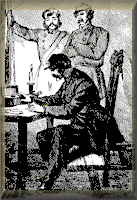USGenWeb Free Census Project Help, About the columns on each page
What is in the columns on the schedules on a year by year basis and Exactly how we want them transcribed
Following is what is found in the columns of the schedules, which differs in most cases for each census year.
Each page there is a header with some or all of the following: State or Territory; County; Date of enumeration; Enumerator's name; Name of incorporated place, township, precinct, or other division; Post Office; page number; sheet number; and sometimes other information this is provided on each page, and some of it can change, so we record it for every page, along with the NARA film number.
For each individual person there is a separate line, in 1860 40 of them per page there are columns on each of these lines to record the following line number; dwelling number; family number; surname; first name; age; sex; color; occupation; value of real estate, value of personal estate, birthplace, whether married within previous 12 months; whether attended school within previous twelve months; whether unable to read or write; whether deaf, dumb, blind, insane, idiotic, pauper, or convict. We also provide a column for remarks for the transcriber to use.
We record EXACTLY what we see on the original, no matter what. blanks we leave blank, long words we leave spelled out, abbreviations we leave abbreviated, initials with periods have periods, those without never do and misspellings NEVER get corrected transcribe means faithfully record exactly as on the original. We don't add punctuation, zeros, or anything else, and we don't subtract anything.
Some columns that must contain an entry are as follows: line number, dwelling number, family number, surname, and given name. There are some occasions when one or more of these is blank on the original some persons have no surname, others no first name. Dwelling and family numbers may occasionally not apply. In these cases, we do place a single dash - in the column, and always explain it in the remarks column. The one instance that does not require explanation is for an unoccupied dwelling, commonly recorded in 1860. For this, there is a line number and dwelling number, a dash for family number, Unoccupied for surname, and a dash for given name. One thing that is NOT recorded as written is the use of ditto, either " or "do". When an above entry has been dittoed by either method, the exact form that is being dittoed is entered. This is most common for surnames, occupations, and birthplaces.
Everything else should be recorded exactly as written.
In 1850, another popular year to work in, some things were different but in general it is handled in the same way.
In 1870, columns are added for whether father or mother was foreign born, if born within previous 12 months, and if eligible to vote or not.
In 1880 we begin the modern census. It is very important that we record the SD (Supervisory District, each state may have more than one) & ED (There are ED's in each SD, each numbering up from zero), and on each line we first have columns for street name and house number in cities. This census first asks relationship to the head of household. It also asks if single, married, widowed, or divorced, and the number of months unemployed during the past 12 for workers. There are also a number of columns for health or condition for each person and for the first time father's and mother's birthplace is recorded.
One other thing I wanted to mention, because there is still confusion. I wanted to make sure that everyone realized that the 1890 population schedules for the whole country were almost completely destroyed. And that for 1890 we have two different records that are frequently confused. The 1890 population schedules ("the census") are absolutely NOT the same thing as the 1890 veterans schedules. (That schedule records Union army and navy veterans of the Civil War and widows of the same. )


